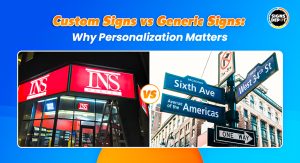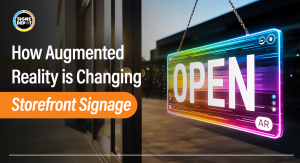
What keeps you hooked while walking in the bustling streets of Toronto, other than the city’s iconic landmarks, skyscrapers, and pleasant climate? Well, the answer is compelling signs that you encounter daily while navigating the city.
From billboards to digital interactive displays in shopping malls, signs in Toronto not only improve the visibility and awareness of the brand but also provide adequate information and guidance for customer engagement. But over the past few years, the growth of technology has increased, and so too has the world of signage. So, what are upcoming signage trends that companies need to pay attention to become trailblazers?
This blog highlights the popular technological trends in the signage field.
The evolution of signage:
Signage has a robust history, coming a long way from the hand-painted signs of ancient times to the neon lights of the 20th century.
In today’s tech-driven society, digital and interactive displays overpower conventional signs. This shift is inspired by technological advancements and the rising demand for more dynamic and intriguing ways to communicate information.
Digital Signage: The current standard
Digital signage is gaining a notable share in today’s signage landscape. According to statistics, the global signage market is expected to grow from $20.1 billion to $27.3 billion by 2029, with a CAGR of 6.3%. The surging demand for 4K and 8K displays, along with other technological advancements, are major factors behind the astonishing growth of the digital signage market.
Digital signs are versatile tools that advertisers can use to display different types of content, from static images to videos and live feeds. They can even update the content in real time, making them incredibly valuable for businesses and public spaces.
To make your digital signs stand out in Toronto’s highly competitive market, you should consult the best sign company with plenty of relevant experience and expertise.
Recommended reading: Digital Signage Revolution: Engaging Customers in the Digital Age
Interactive signage: engaging the audience
While planning signage for your company, you need to consider audience engagement. Interactive signs exactly do the same thing. These signs allow customers to engage directly with the content.
The signs come up with intriguing features like touchscreens, motion sensors, or even voice recognition technology. For example, interactive kiosks in Toronto’s popular shopping malls guide customers to relevant stores, check product availability, and even make purchases. The interactivity not only improves customer shopping experience but also embraces the brand with valuable data insights on customers’ behavior.
Augmented Reality (AR) and Virtual Reality (VR)
AR and VR technologies are key drivers of the signage revolution. They create immersive experiences that merge the physical and digital worlds.
You just passed a storefront in Toronto’s market and immediately noticed a virtual display that portrays the store’s products in 3D, inspiring you to explore them further. This engagement level can improve how businesses fascinate and retain customers.
According to a study report by Deloitte, about 88% of mid-sized companies adopted AR in some capacity, and this number is expected to grow higher in future with further intrusion of technology. Brands may integrate AR into wayfinding signage to overlay directions onto the real world, making it simpler for customers to navigate intricate business environments like airports or large office buildings.
Smart signage: The integration of IoT
The Internet of Things (IoT) is shaping the future of many industries, and signage is no exception.
Smart signs are paired with the internet and can interact with other devices and systems. This connectivity allows for plenty of upgraded features, such as real-time content updates, remote management, and data collection from various devices.
For example, a smart billboard may alter its message based on the time of day, weather conditions, or the demographics of the passing audience. Now, your signs become more relevant and impactful and drive more engagement.
Sustainability in Signage
As environmental concerns become more pressing, the signage industry is prioritizing sustainable approaches.
Conventional signs made from non-recyclable materials and inefficient lighting have a significant environmental footprint. On the other hand, modern signs are designed exclusively with energy efficiency and sustainability in mind.
Digital signs use LED technology that consumes less power than traditional lighting. Moreover, you don’t need to use paper and other disposable materials while making digital signs, contributing to a decrease in waste.
The Role of Artificial Intelligence (AI)
AI is another game-changer when we talk about the signage revolution.
By analyzing data, AI-driven signs make decisions in real time and optimize the content displayed based on various factors. An AI system can regulate advertisements on a digital billboard to target specific demographics based on the time of day, weather, or even the current trending topics on social media platforms.
AI uplifts signs’ interactivity. Users can ask questions and receive customized recommendations based on voice-activated signs, creating a more engaging and interactive experience. According to a report by PwC, AI will contribute $15.7 trillion to the global economy by 2030, indicating its huge significance across various industries, including signage.
Recommended reading: The Canadian Digital Signage Market: Trends, Opportunities and Prospects
The future of signage: predictions and Possibilities
The future of digital signs is scintillating as more digital advancements are on the queue. Signage will evolve and continue with future trends and new technologies. Here are a few predictions of what you expect in upcoming years.
- Holographic signage: Holographic displays will grab attention in future, providing three-dimensional images that create a high-tech aesthetic.
- Biometric integration: The best sign shops in Toronto will design signs equipped with biometric sensors. These signs will offer personalized content to viewers based on their age, gender, or even emotional state.
- Sustainable materials: Sign companies are looking for sustainable or biodegradable materials to minimize the environmental impact.
- Increased personalization: In future, more signs will use predictive analytics and other tools to offer personalized and targeted messages that resonate with individual viewers.
Conclusion:
Now, you can confidently claim that the world of signage is on the verge of a significant technological revolution. As digital, interactive, and smart signs become more dominant, the ways we convey information will become more diverse, engaging, and efficient.
Organizations that adopt these innovations will not only surpass their contenders but also provide more value to their consumers.
In a world where attention is the cornerstone of a business’s success, innovative signage solutions will play a critical role in catching and retaining that attention. As we progress day by day, the possibilities are fathomless, and the only limit is our imagination.
So, how do you integrate technology into your signage solutions? Don’t hesitate to write to us.
Do you want to make your signs infused with technology? Get in touch with Signs Depot, the best sign company in Toronto for innovative signage solutions. Our sign experts know how to design digital signs for your company to enhance engagement and awareness.
We also design indoor, outdoor, and custom signs as per our client’s requirements.
Faqs
What are the risks of digital signs?
Digital signs are susceptible to several risks, including cybersecurity threats like hacking and data breaches, potential technical malfunctions, high maintenance costs, and vulnerability to weather-related damage. Privacy concerns also arise with interactive and data-collecting features, posing potential legal and ethical issues.
What is the cost of a digital sign?
The cost of a digital sign varies widely based on size, resolution, and features. Basic small indoor displays can start at around $300, while large outdoor digital billboards cost over $200,000.



